Intrusive Animal Testing in Science Research: Alternatives & Ethics
VerifiedAdded on 2023/06/13
|8
|2195
|201
Essay
AI Summary
This essay critically examines the ethical implications of subjecting animals to intrusive testing in scientific research, arguing that advancements in technology and medicine have rendered such practices unnecessary and unethical. The author highlights the historical context of animal testing, its harmful effects on animals, and the availability of alternative testing techniques such as simulation programs and the use of human cell tissues. The essay emphasizes the importance of the 3R principle (replacing, refining, and reducing) in animal research and presents statistical data illustrating the high number of animals that die annually due to experimental research. It concludes by recommending the elimination of animal testing in the biomedical sector and advocating for the adoption of more ethical and technologically advanced alternatives, while also emphasizing the availability of similar resources for students on Desklib.
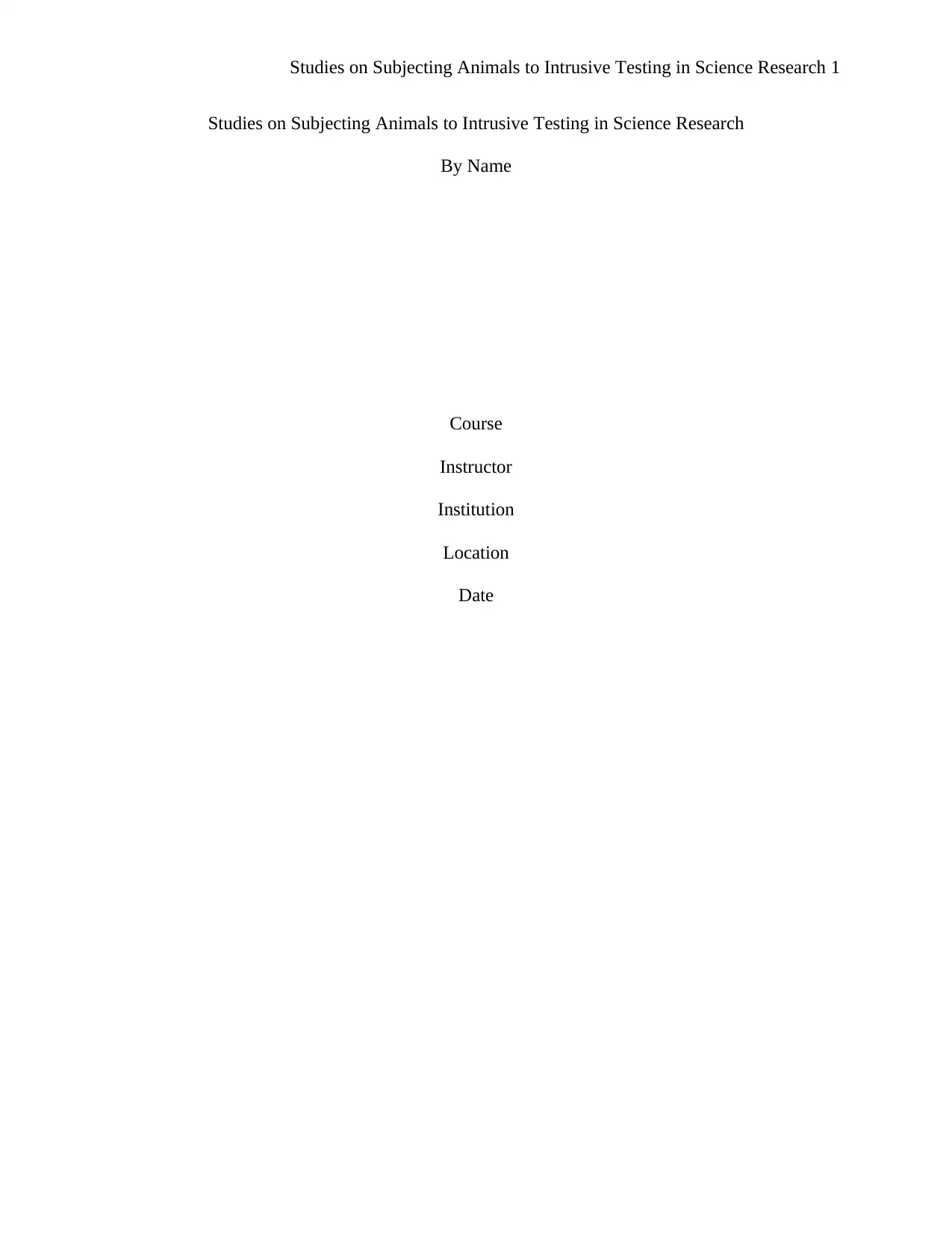
Studies on Subjecting Animals to Intrusive Testing in Science Research 1
Studies on Subjecting Animals to Intrusive Testing in Science Research
By Name
Course
Instructor
Institution
Location
Date
Studies on Subjecting Animals to Intrusive Testing in Science Research
By Name
Course
Instructor
Institution
Location
Date
Paraphrase This Document
Need a fresh take? Get an instant paraphrase of this document with our AI Paraphraser
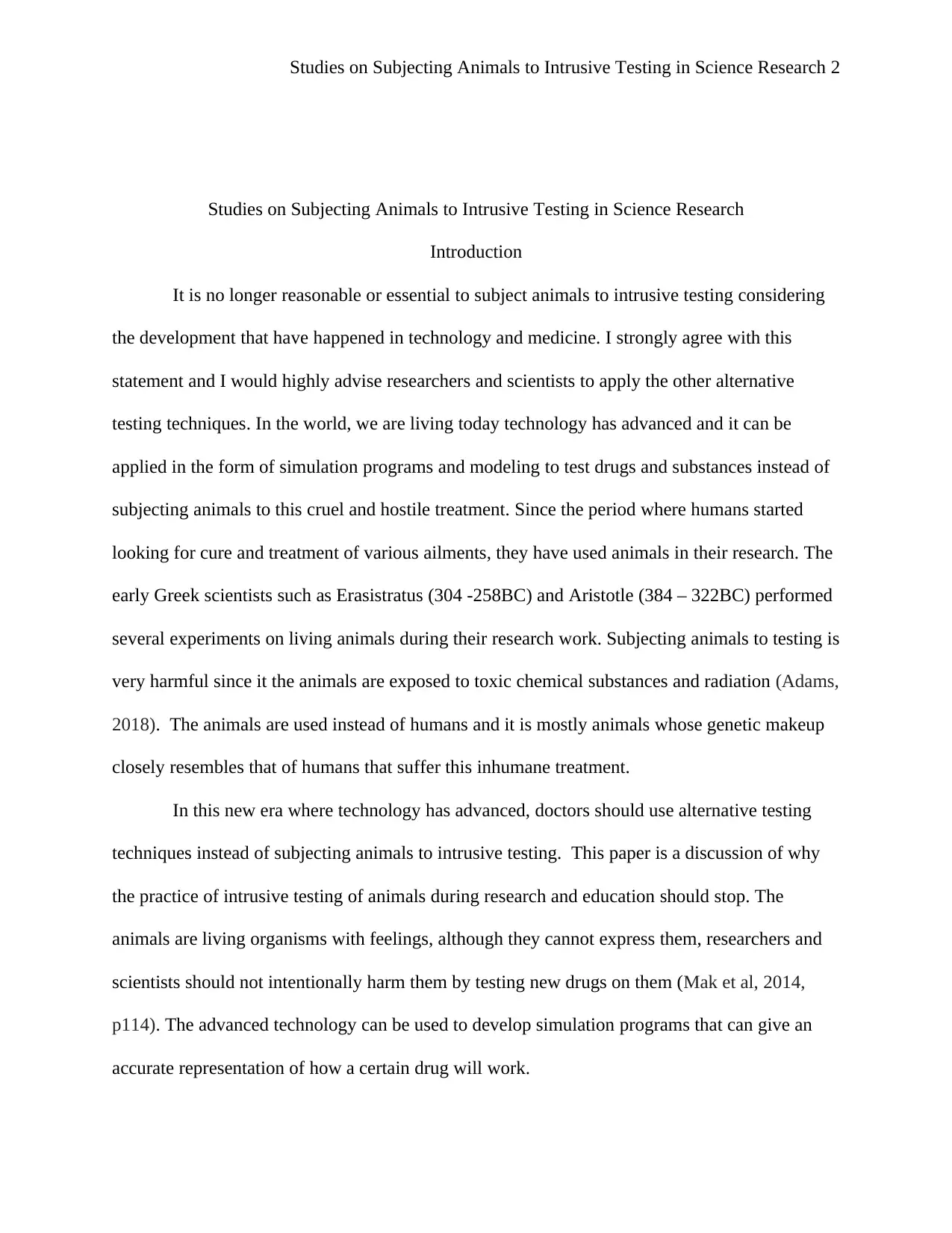
Studies on Subjecting Animals to Intrusive Testing in Science Research 2
Studies on Subjecting Animals to Intrusive Testing in Science Research
Introduction
It is no longer reasonable or essential to subject animals to intrusive testing considering
the development that have happened in technology and medicine. I strongly agree with this
statement and I would highly advise researchers and scientists to apply the other alternative
testing techniques. In the world, we are living today technology has advanced and it can be
applied in the form of simulation programs and modeling to test drugs and substances instead of
subjecting animals to this cruel and hostile treatment. Since the period where humans started
looking for cure and treatment of various ailments, they have used animals in their research. The
early Greek scientists such as Erasistratus (304 -258BC) and Aristotle (384 – 322BC) performed
several experiments on living animals during their research work. Subjecting animals to testing is
very harmful since it the animals are exposed to toxic chemical substances and radiation (Adams,
2018). The animals are used instead of humans and it is mostly animals whose genetic makeup
closely resembles that of humans that suffer this inhumane treatment.
In this new era where technology has advanced, doctors should use alternative testing
techniques instead of subjecting animals to intrusive testing. This paper is a discussion of why
the practice of intrusive testing of animals during research and education should stop. The
animals are living organisms with feelings, although they cannot express them, researchers and
scientists should not intentionally harm them by testing new drugs on them (Mak et al, 2014,
p114). The advanced technology can be used to develop simulation programs that can give an
accurate representation of how a certain drug will work.
Studies on Subjecting Animals to Intrusive Testing in Science Research
Introduction
It is no longer reasonable or essential to subject animals to intrusive testing considering
the development that have happened in technology and medicine. I strongly agree with this
statement and I would highly advise researchers and scientists to apply the other alternative
testing techniques. In the world, we are living today technology has advanced and it can be
applied in the form of simulation programs and modeling to test drugs and substances instead of
subjecting animals to this cruel and hostile treatment. Since the period where humans started
looking for cure and treatment of various ailments, they have used animals in their research. The
early Greek scientists such as Erasistratus (304 -258BC) and Aristotle (384 – 322BC) performed
several experiments on living animals during their research work. Subjecting animals to testing is
very harmful since it the animals are exposed to toxic chemical substances and radiation (Adams,
2018). The animals are used instead of humans and it is mostly animals whose genetic makeup
closely resembles that of humans that suffer this inhumane treatment.
In this new era where technology has advanced, doctors should use alternative testing
techniques instead of subjecting animals to intrusive testing. This paper is a discussion of why
the practice of intrusive testing of animals during research and education should stop. The
animals are living organisms with feelings, although they cannot express them, researchers and
scientists should not intentionally harm them by testing new drugs on them (Mak et al, 2014,
p114). The advanced technology can be used to develop simulation programs that can give an
accurate representation of how a certain drug will work.
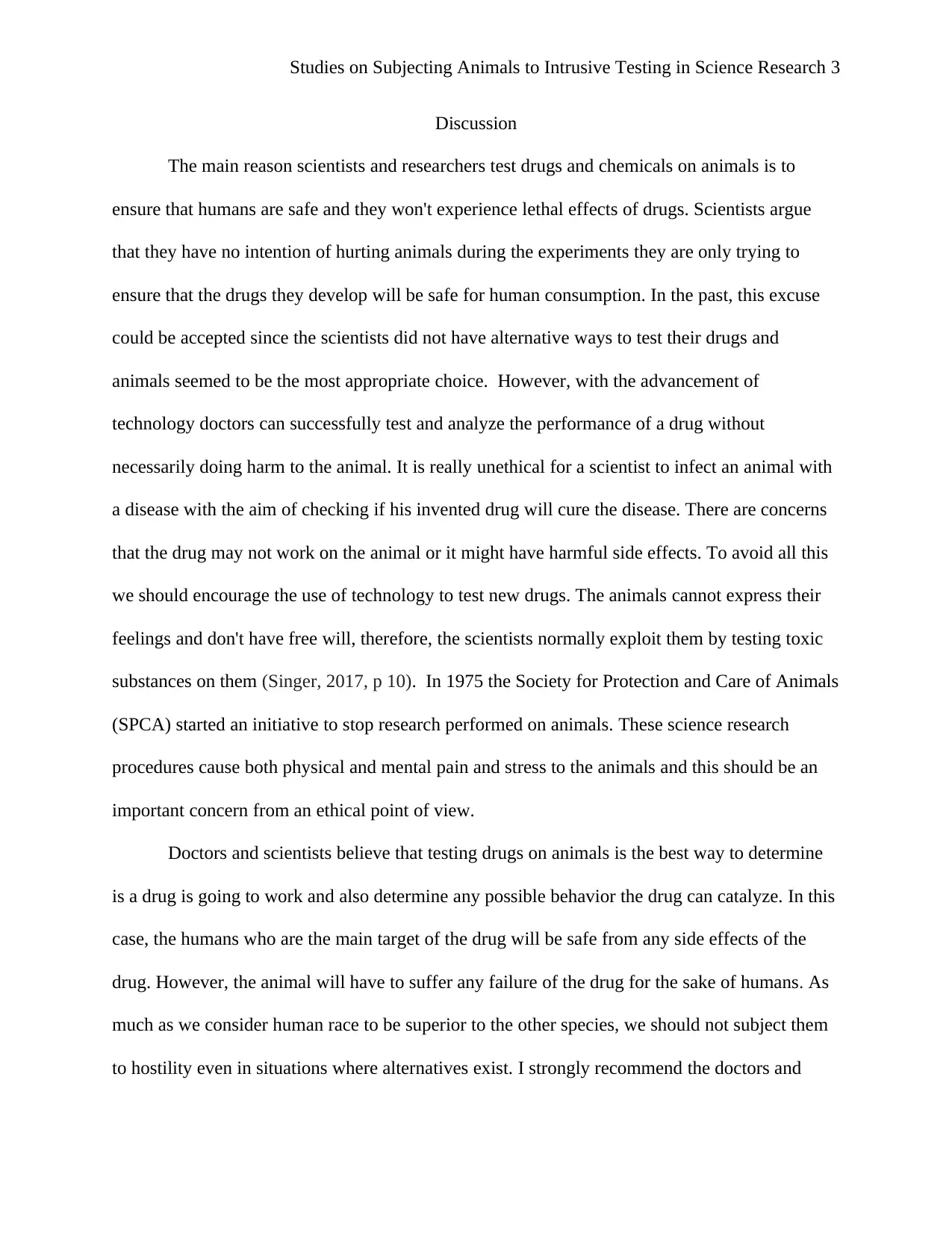
Studies on Subjecting Animals to Intrusive Testing in Science Research 3
Discussion
The main reason scientists and researchers test drugs and chemicals on animals is to
ensure that humans are safe and they won't experience lethal effects of drugs. Scientists argue
that they have no intention of hurting animals during the experiments they are only trying to
ensure that the drugs they develop will be safe for human consumption. In the past, this excuse
could be accepted since the scientists did not have alternative ways to test their drugs and
animals seemed to be the most appropriate choice. However, with the advancement of
technology doctors can successfully test and analyze the performance of a drug without
necessarily doing harm to the animal. It is really unethical for a scientist to infect an animal with
a disease with the aim of checking if his invented drug will cure the disease. There are concerns
that the drug may not work on the animal or it might have harmful side effects. To avoid all this
we should encourage the use of technology to test new drugs. The animals cannot express their
feelings and don't have free will, therefore, the scientists normally exploit them by testing toxic
substances on them (Singer, 2017, p 10). In 1975 the Society for Protection and Care of Animals
(SPCA) started an initiative to stop research performed on animals. These science research
procedures cause both physical and mental pain and stress to the animals and this should be an
important concern from an ethical point of view.
Doctors and scientists believe that testing drugs on animals is the best way to determine
is a drug is going to work and also determine any possible behavior the drug can catalyze. In this
case, the humans who are the main target of the drug will be safe from any side effects of the
drug. However, the animal will have to suffer any failure of the drug for the sake of humans. As
much as we consider human race to be superior to the other species, we should not subject them
to hostility even in situations where alternatives exist. I strongly recommend the doctors and
Discussion
The main reason scientists and researchers test drugs and chemicals on animals is to
ensure that humans are safe and they won't experience lethal effects of drugs. Scientists argue
that they have no intention of hurting animals during the experiments they are only trying to
ensure that the drugs they develop will be safe for human consumption. In the past, this excuse
could be accepted since the scientists did not have alternative ways to test their drugs and
animals seemed to be the most appropriate choice. However, with the advancement of
technology doctors can successfully test and analyze the performance of a drug without
necessarily doing harm to the animal. It is really unethical for a scientist to infect an animal with
a disease with the aim of checking if his invented drug will cure the disease. There are concerns
that the drug may not work on the animal or it might have harmful side effects. To avoid all this
we should encourage the use of technology to test new drugs. The animals cannot express their
feelings and don't have free will, therefore, the scientists normally exploit them by testing toxic
substances on them (Singer, 2017, p 10). In 1975 the Society for Protection and Care of Animals
(SPCA) started an initiative to stop research performed on animals. These science research
procedures cause both physical and mental pain and stress to the animals and this should be an
important concern from an ethical point of view.
Doctors and scientists believe that testing drugs on animals is the best way to determine
is a drug is going to work and also determine any possible behavior the drug can catalyze. In this
case, the humans who are the main target of the drug will be safe from any side effects of the
drug. However, the animal will have to suffer any failure of the drug for the sake of humans. As
much as we consider human race to be superior to the other species, we should not subject them
to hostility even in situations where alternatives exist. I strongly recommend the doctors and
⊘ This is a preview!⊘
Do you want full access?
Subscribe today to unlock all pages.

Trusted by 1+ million students worldwide
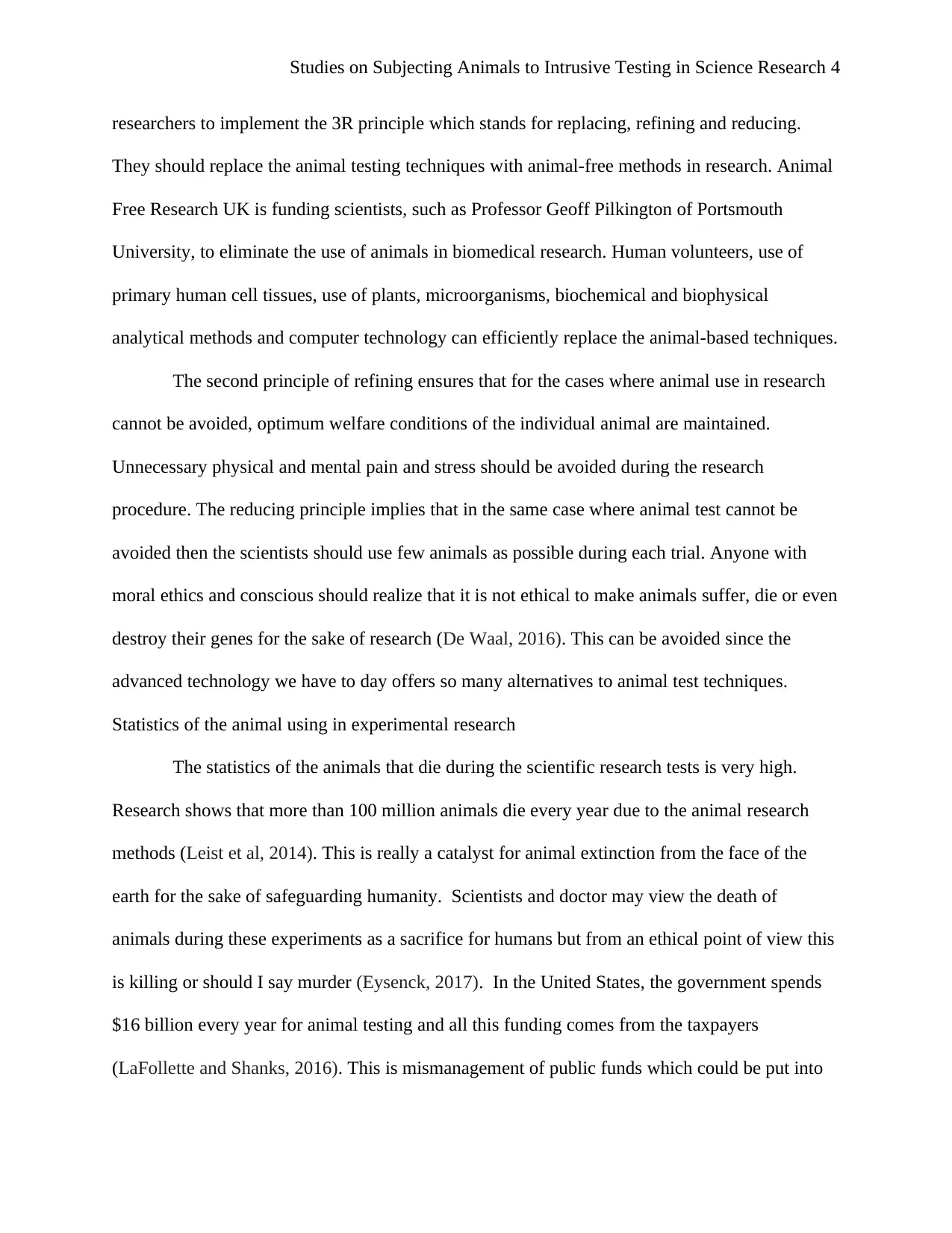
Studies on Subjecting Animals to Intrusive Testing in Science Research 4
researchers to implement the 3R principle which stands for replacing, refining and reducing.
They should replace the animal testing techniques with animal-free methods in research. Animal
Free Research UK is funding scientists, such as Professor Geoff Pilkington of Portsmouth
University, to eliminate the use of animals in biomedical research. Human volunteers, use of
primary human cell tissues, use of plants, microorganisms, biochemical and biophysical
analytical methods and computer technology can efficiently replace the animal-based techniques.
The second principle of refining ensures that for the cases where animal use in research
cannot be avoided, optimum welfare conditions of the individual animal are maintained.
Unnecessary physical and mental pain and stress should be avoided during the research
procedure. The reducing principle implies that in the same case where animal test cannot be
avoided then the scientists should use few animals as possible during each trial. Anyone with
moral ethics and conscious should realize that it is not ethical to make animals suffer, die or even
destroy their genes for the sake of research (De Waal, 2016). This can be avoided since the
advanced technology we have to day offers so many alternatives to animal test techniques.
Statistics of the animal using in experimental research
The statistics of the animals that die during the scientific research tests is very high.
Research shows that more than 100 million animals die every year due to the animal research
methods (Leist et al, 2014). This is really a catalyst for animal extinction from the face of the
earth for the sake of safeguarding humanity. Scientists and doctor may view the death of
animals during these experiments as a sacrifice for humans but from an ethical point of view this
is killing or should I say murder (Eysenck, 2017). In the United States, the government spends
$16 billion every year for animal testing and all this funding comes from the taxpayers
(LaFollette and Shanks, 2016). This is mismanagement of public funds which could be put into
researchers to implement the 3R principle which stands for replacing, refining and reducing.
They should replace the animal testing techniques with animal-free methods in research. Animal
Free Research UK is funding scientists, such as Professor Geoff Pilkington of Portsmouth
University, to eliminate the use of animals in biomedical research. Human volunteers, use of
primary human cell tissues, use of plants, microorganisms, biochemical and biophysical
analytical methods and computer technology can efficiently replace the animal-based techniques.
The second principle of refining ensures that for the cases where animal use in research
cannot be avoided, optimum welfare conditions of the individual animal are maintained.
Unnecessary physical and mental pain and stress should be avoided during the research
procedure. The reducing principle implies that in the same case where animal test cannot be
avoided then the scientists should use few animals as possible during each trial. Anyone with
moral ethics and conscious should realize that it is not ethical to make animals suffer, die or even
destroy their genes for the sake of research (De Waal, 2016). This can be avoided since the
advanced technology we have to day offers so many alternatives to animal test techniques.
Statistics of the animal using in experimental research
The statistics of the animals that die during the scientific research tests is very high.
Research shows that more than 100 million animals die every year due to the animal research
methods (Leist et al, 2014). This is really a catalyst for animal extinction from the face of the
earth for the sake of safeguarding humanity. Scientists and doctor may view the death of
animals during these experiments as a sacrifice for humans but from an ethical point of view this
is killing or should I say murder (Eysenck, 2017). In the United States, the government spends
$16 billion every year for animal testing and all this funding comes from the taxpayers
(LaFollette and Shanks, 2016). This is mismanagement of public funds which could be put into
Paraphrase This Document
Need a fresh take? Get an instant paraphrase of this document with our AI Paraphraser
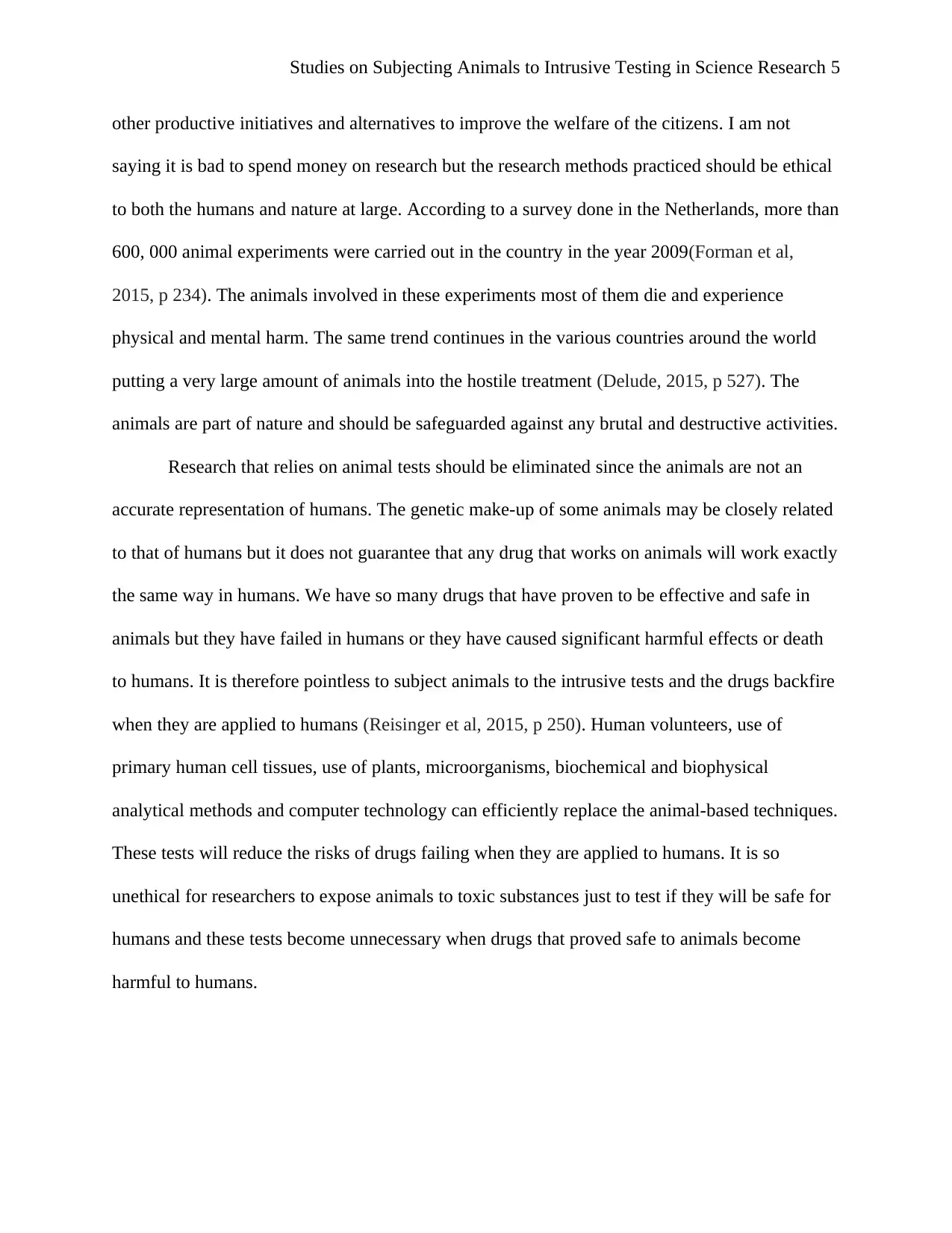
Studies on Subjecting Animals to Intrusive Testing in Science Research 5
other productive initiatives and alternatives to improve the welfare of the citizens. I am not
saying it is bad to spend money on research but the research methods practiced should be ethical
to both the humans and nature at large. According to a survey done in the Netherlands, more than
600, 000 animal experiments were carried out in the country in the year 2009(Forman et al,
2015, p 234). The animals involved in these experiments most of them die and experience
physical and mental harm. The same trend continues in the various countries around the world
putting a very large amount of animals into the hostile treatment (Delude, 2015, p 527). The
animals are part of nature and should be safeguarded against any brutal and destructive activities.
Research that relies on animal tests should be eliminated since the animals are not an
accurate representation of humans. The genetic make-up of some animals may be closely related
to that of humans but it does not guarantee that any drug that works on animals will work exactly
the same way in humans. We have so many drugs that have proven to be effective and safe in
animals but they have failed in humans or they have caused significant harmful effects or death
to humans. It is therefore pointless to subject animals to the intrusive tests and the drugs backfire
when they are applied to humans (Reisinger et al, 2015, p 250). Human volunteers, use of
primary human cell tissues, use of plants, microorganisms, biochemical and biophysical
analytical methods and computer technology can efficiently replace the animal-based techniques.
These tests will reduce the risks of drugs failing when they are applied to humans. It is so
unethical for researchers to expose animals to toxic substances just to test if they will be safe for
humans and these tests become unnecessary when drugs that proved safe to animals become
harmful to humans.
other productive initiatives and alternatives to improve the welfare of the citizens. I am not
saying it is bad to spend money on research but the research methods practiced should be ethical
to both the humans and nature at large. According to a survey done in the Netherlands, more than
600, 000 animal experiments were carried out in the country in the year 2009(Forman et al,
2015, p 234). The animals involved in these experiments most of them die and experience
physical and mental harm. The same trend continues in the various countries around the world
putting a very large amount of animals into the hostile treatment (Delude, 2015, p 527). The
animals are part of nature and should be safeguarded against any brutal and destructive activities.
Research that relies on animal tests should be eliminated since the animals are not an
accurate representation of humans. The genetic make-up of some animals may be closely related
to that of humans but it does not guarantee that any drug that works on animals will work exactly
the same way in humans. We have so many drugs that have proven to be effective and safe in
animals but they have failed in humans or they have caused significant harmful effects or death
to humans. It is therefore pointless to subject animals to the intrusive tests and the drugs backfire
when they are applied to humans (Reisinger et al, 2015, p 250). Human volunteers, use of
primary human cell tissues, use of plants, microorganisms, biochemical and biophysical
analytical methods and computer technology can efficiently replace the animal-based techniques.
These tests will reduce the risks of drugs failing when they are applied to humans. It is so
unethical for researchers to expose animals to toxic substances just to test if they will be safe for
humans and these tests become unnecessary when drugs that proved safe to animals become
harmful to humans.
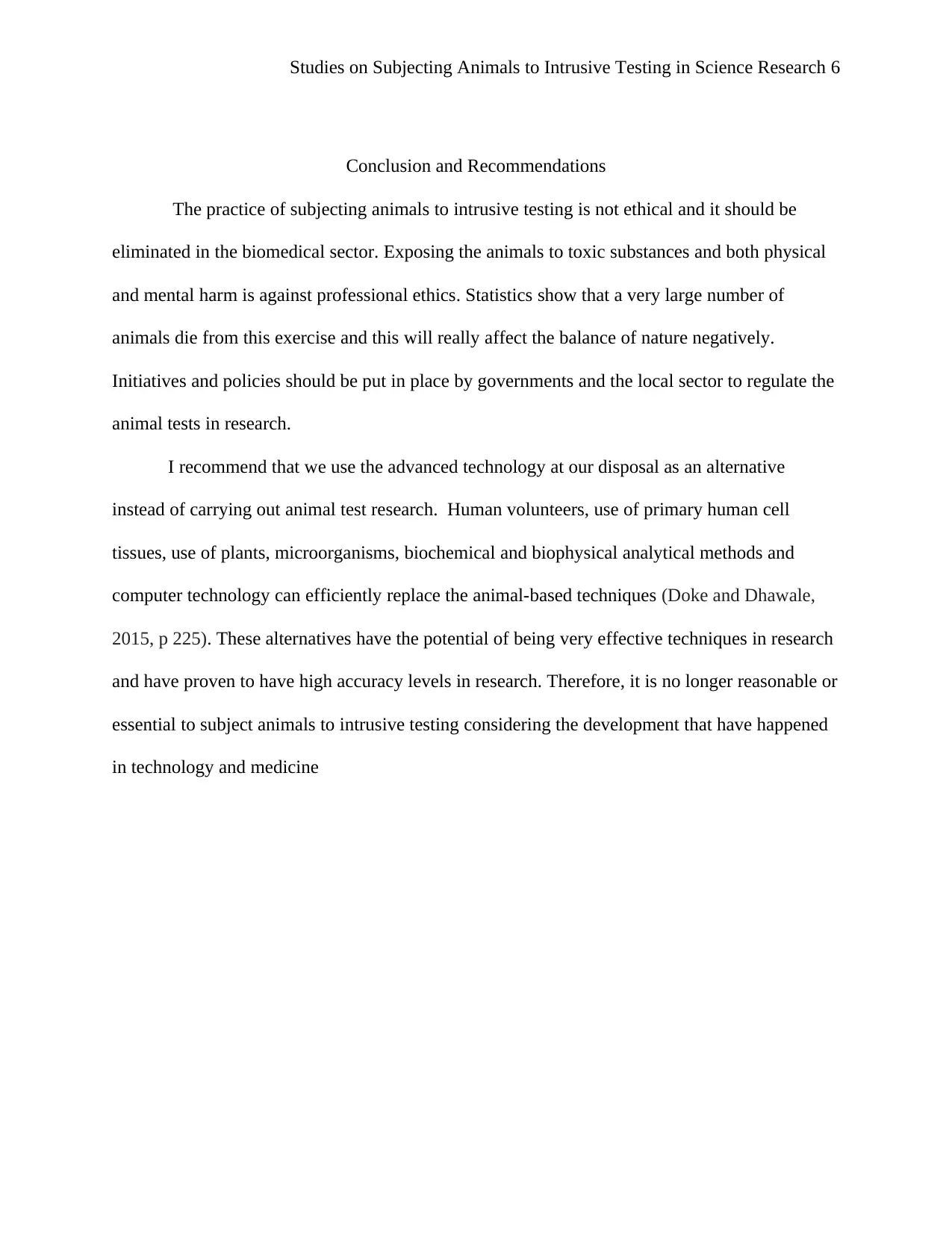
Studies on Subjecting Animals to Intrusive Testing in Science Research 6
Conclusion and Recommendations
The practice of subjecting animals to intrusive testing is not ethical and it should be
eliminated in the biomedical sector. Exposing the animals to toxic substances and both physical
and mental harm is against professional ethics. Statistics show that a very large number of
animals die from this exercise and this will really affect the balance of nature negatively.
Initiatives and policies should be put in place by governments and the local sector to regulate the
animal tests in research.
I recommend that we use the advanced technology at our disposal as an alternative
instead of carrying out animal test research. Human volunteers, use of primary human cell
tissues, use of plants, microorganisms, biochemical and biophysical analytical methods and
computer technology can efficiently replace the animal-based techniques (Doke and Dhawale,
2015, p 225). These alternatives have the potential of being very effective techniques in research
and have proven to have high accuracy levels in research. Therefore, it is no longer reasonable or
essential to subject animals to intrusive testing considering the development that have happened
in technology and medicine
Conclusion and Recommendations
The practice of subjecting animals to intrusive testing is not ethical and it should be
eliminated in the biomedical sector. Exposing the animals to toxic substances and both physical
and mental harm is against professional ethics. Statistics show that a very large number of
animals die from this exercise and this will really affect the balance of nature negatively.
Initiatives and policies should be put in place by governments and the local sector to regulate the
animal tests in research.
I recommend that we use the advanced technology at our disposal as an alternative
instead of carrying out animal test research. Human volunteers, use of primary human cell
tissues, use of plants, microorganisms, biochemical and biophysical analytical methods and
computer technology can efficiently replace the animal-based techniques (Doke and Dhawale,
2015, p 225). These alternatives have the potential of being very effective techniques in research
and have proven to have high accuracy levels in research. Therefore, it is no longer reasonable or
essential to subject animals to intrusive testing considering the development that have happened
in technology and medicine
⊘ This is a preview!⊘
Do you want full access?
Subscribe today to unlock all pages.

Trusted by 1+ million students worldwide
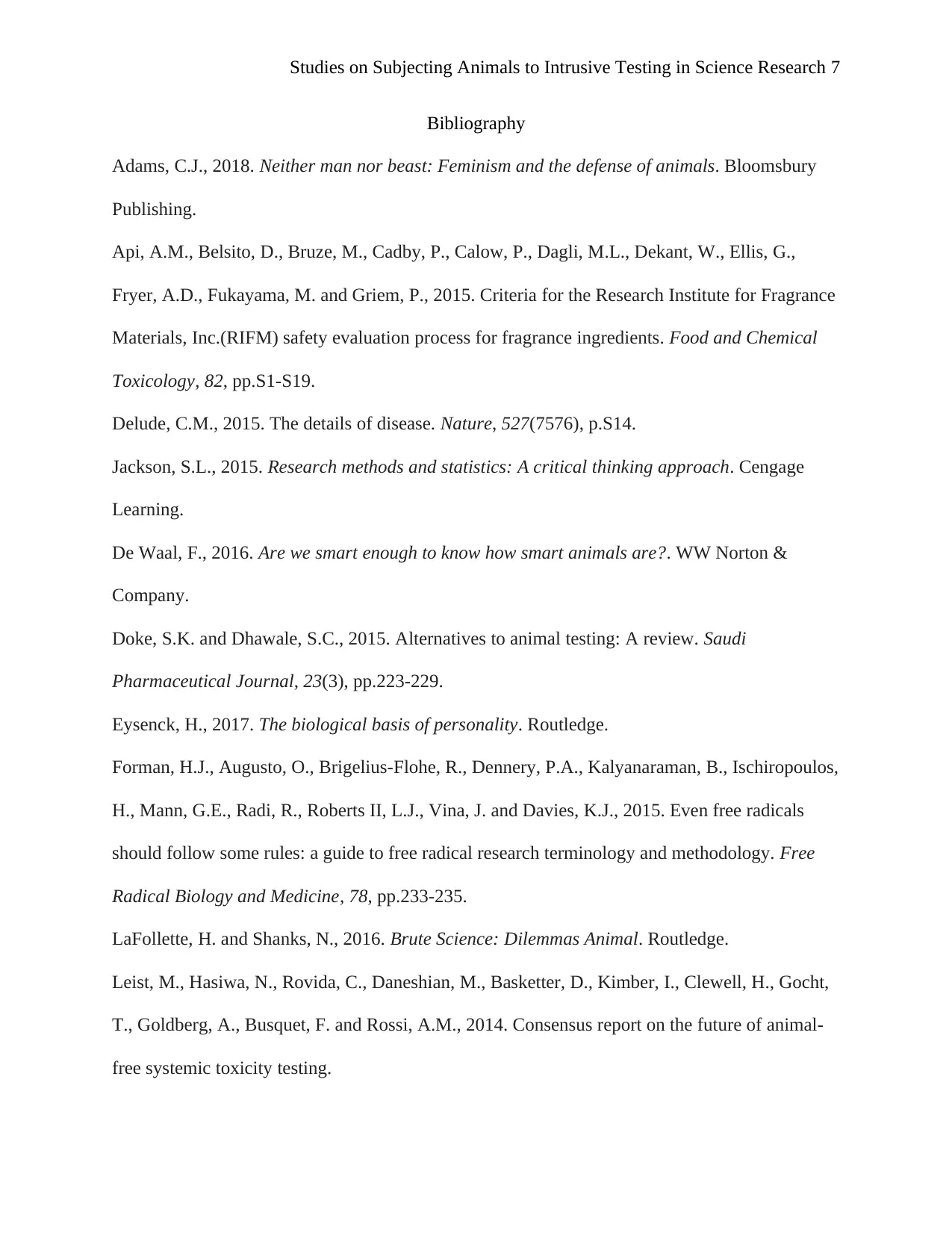
Studies on Subjecting Animals to Intrusive Testing in Science Research 7
Bibliography
Adams, C.J., 2018. Neither man nor beast: Feminism and the defense of animals. Bloomsbury
Publishing.
Api, A.M., Belsito, D., Bruze, M., Cadby, P., Calow, P., Dagli, M.L., Dekant, W., Ellis, G.,
Fryer, A.D., Fukayama, M. and Griem, P., 2015. Criteria for the Research Institute for Fragrance
Materials, Inc.(RIFM) safety evaluation process for fragrance ingredients. Food and Chemical
Toxicology, 82, pp.S1-S19.
Delude, C.M., 2015. The details of disease. Nature, 527(7576), p.S14.
Jackson, S.L., 2015. Research methods and statistics: A critical thinking approach. Cengage
Learning.
De Waal, F., 2016. Are we smart enough to know how smart animals are?. WW Norton &
Company.
Doke, S.K. and Dhawale, S.C., 2015. Alternatives to animal testing: A review. Saudi
Pharmaceutical Journal, 23(3), pp.223-229.
Eysenck, H., 2017. The biological basis of personality. Routledge.
Forman, H.J., Augusto, O., Brigelius-Flohe, R., Dennery, P.A., Kalyanaraman, B., Ischiropoulos,
H., Mann, G.E., Radi, R., Roberts II, L.J., Vina, J. and Davies, K.J., 2015. Even free radicals
should follow some rules: a guide to free radical research terminology and methodology. Free
Radical Biology and Medicine, 78, pp.233-235.
LaFollette, H. and Shanks, N., 2016. Brute Science: Dilemmas Animal. Routledge.
Leist, M., Hasiwa, N., Rovida, C., Daneshian, M., Basketter, D., Kimber, I., Clewell, H., Gocht,
T., Goldberg, A., Busquet, F. and Rossi, A.M., 2014. Consensus report on the future of animal-
free systemic toxicity testing.
Bibliography
Adams, C.J., 2018. Neither man nor beast: Feminism and the defense of animals. Bloomsbury
Publishing.
Api, A.M., Belsito, D., Bruze, M., Cadby, P., Calow, P., Dagli, M.L., Dekant, W., Ellis, G.,
Fryer, A.D., Fukayama, M. and Griem, P., 2015. Criteria for the Research Institute for Fragrance
Materials, Inc.(RIFM) safety evaluation process for fragrance ingredients. Food and Chemical
Toxicology, 82, pp.S1-S19.
Delude, C.M., 2015. The details of disease. Nature, 527(7576), p.S14.
Jackson, S.L., 2015. Research methods and statistics: A critical thinking approach. Cengage
Learning.
De Waal, F., 2016. Are we smart enough to know how smart animals are?. WW Norton &
Company.
Doke, S.K. and Dhawale, S.C., 2015. Alternatives to animal testing: A review. Saudi
Pharmaceutical Journal, 23(3), pp.223-229.
Eysenck, H., 2017. The biological basis of personality. Routledge.
Forman, H.J., Augusto, O., Brigelius-Flohe, R., Dennery, P.A., Kalyanaraman, B., Ischiropoulos,
H., Mann, G.E., Radi, R., Roberts II, L.J., Vina, J. and Davies, K.J., 2015. Even free radicals
should follow some rules: a guide to free radical research terminology and methodology. Free
Radical Biology and Medicine, 78, pp.233-235.
LaFollette, H. and Shanks, N., 2016. Brute Science: Dilemmas Animal. Routledge.
Leist, M., Hasiwa, N., Rovida, C., Daneshian, M., Basketter, D., Kimber, I., Clewell, H., Gocht,
T., Goldberg, A., Busquet, F. and Rossi, A.M., 2014. Consensus report on the future of animal-
free systemic toxicity testing.
Paraphrase This Document
Need a fresh take? Get an instant paraphrase of this document with our AI Paraphraser
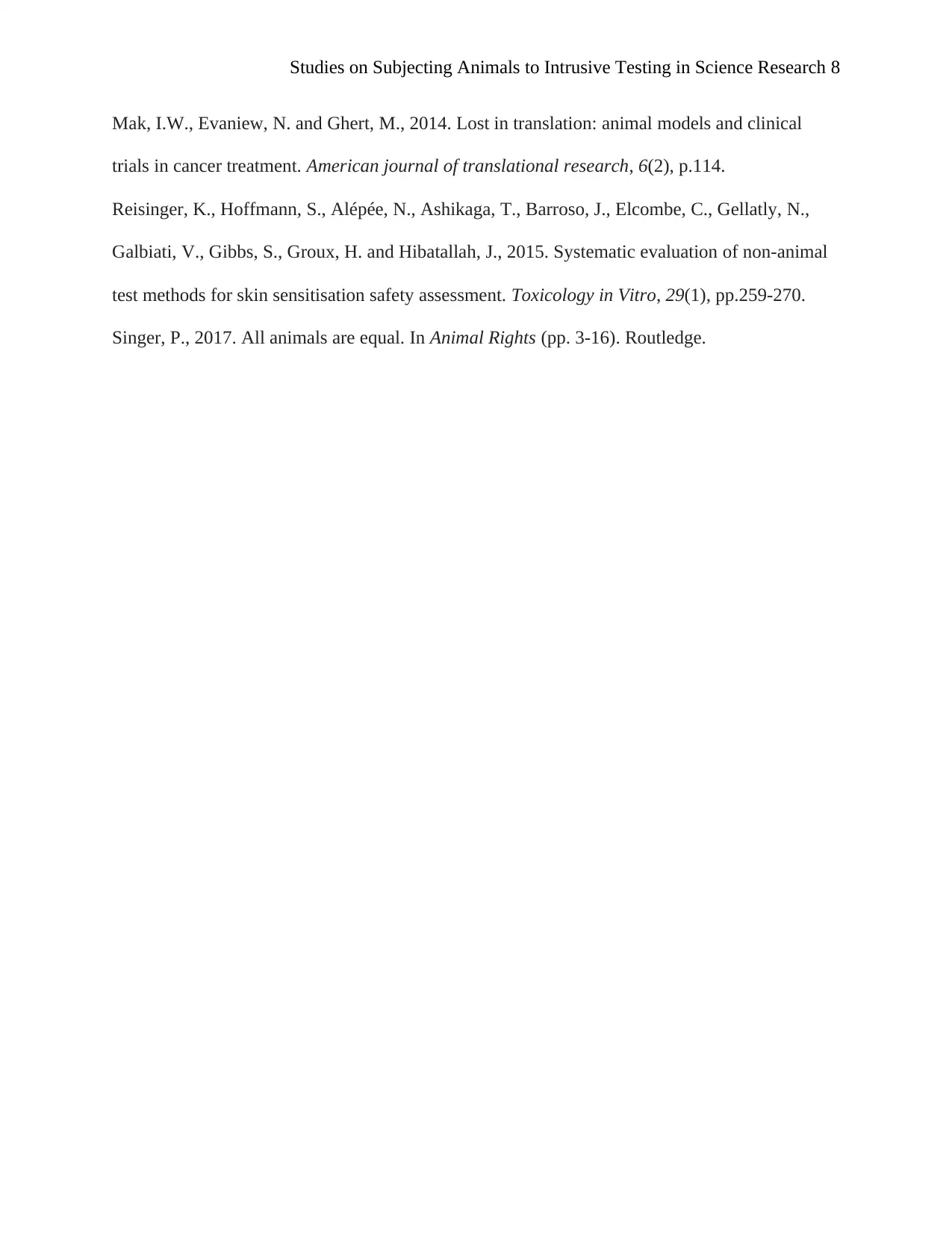
Studies on Subjecting Animals to Intrusive Testing in Science Research 8
Mak, I.W., Evaniew, N. and Ghert, M., 2014. Lost in translation: animal models and clinical
trials in cancer treatment. American journal of translational research, 6(2), p.114.
Reisinger, K., Hoffmann, S., Alépée, N., Ashikaga, T., Barroso, J., Elcombe, C., Gellatly, N.,
Galbiati, V., Gibbs, S., Groux, H. and Hibatallah, J., 2015. Systematic evaluation of non-animal
test methods for skin sensitisation safety assessment. Toxicology in Vitro, 29(1), pp.259-270.
Singer, P., 2017. All animals are equal. In Animal Rights (pp. 3-16). Routledge.
Mak, I.W., Evaniew, N. and Ghert, M., 2014. Lost in translation: animal models and clinical
trials in cancer treatment. American journal of translational research, 6(2), p.114.
Reisinger, K., Hoffmann, S., Alépée, N., Ashikaga, T., Barroso, J., Elcombe, C., Gellatly, N.,
Galbiati, V., Gibbs, S., Groux, H. and Hibatallah, J., 2015. Systematic evaluation of non-animal
test methods for skin sensitisation safety assessment. Toxicology in Vitro, 29(1), pp.259-270.
Singer, P., 2017. All animals are equal. In Animal Rights (pp. 3-16). Routledge.
1 out of 8
Related Documents
Your All-in-One AI-Powered Toolkit for Academic Success.
+13062052269
info@desklib.com
Available 24*7 on WhatsApp / Email
![[object Object]](/_next/static/media/star-bottom.7253800d.svg)
Unlock your academic potential
Copyright © 2020–2025 A2Z Services. All Rights Reserved. Developed and managed by ZUCOL.





